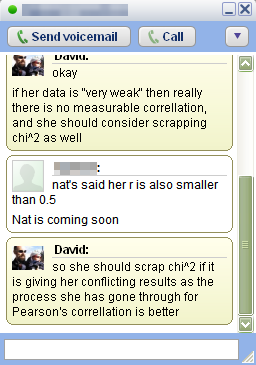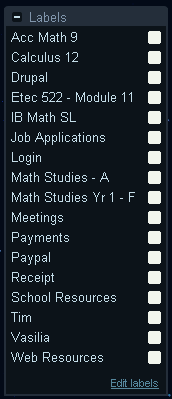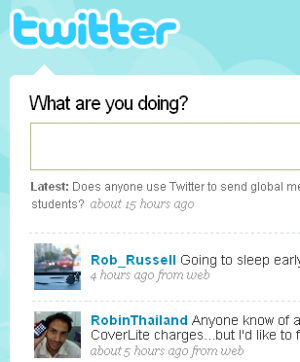Abstract
This paper discusses the importance of teacher training in technology. One important question is looked at, specifically; does training in technology lead to increased student achievement? Following a review of current literature in this area, we look at possible answers to this question and reasons why teachers often receive less technology training than they require.
Introduction
One thing my colleagues are always complaining about when it comes to technology is a lack of adequate training in how to use technology. A common complaint at every school I have worked at has been about how teachers are given technology to use, some of it very expensive, and not given enough training to use the technology effectively. This is a complaint that many people in our class discussions have brought up. A useful question to ask then is, how much of a difference does training teachers to use technology make on the performance of their students? Assuming that student performance, however it is measured, is linked to teacher preparation, we can hypothesize that there is a relationship between training teachers how to use technology effectively, and student achievement.
Review of Current Literature
An important part of answering this question is addressing the issue of how well educational research is done in the area of technology since we need to know how good the tools are that will be used to answer this question. Kozma (2000) discusses this issue and decides that much work needs to be done improving our current educational research practices. He emphasizes that "Perhaps it is the paradigm rather than the researchers or the user community that needs to change." This suggests that we need to look at how we do educational research differently but the existing ways in which we collaborate are functional.
According to Cradler, J., Freeman, M., Cradler, R., McNabb, M. (2002),"A careful review of studies shows that more than the specific technology or software used, the context in which technology is applied is critical to the educator." The authors suggest that when training teachers to use technology in the classroom, one should focus on how the technology is useful, rather than which technology is most useful. This seems to me to be true, except that the typical level of comfort with technology that teachers have is low enough that theory will be of no use to teachers without specific examples to draw upon and learn about. Therefore, training sessions should be used for a balance between practical hands-on examples and the theory behind the use of technology.
To paraphrase Brand, G. A. (1997) teacher training, in the area of technology especially, should:
"be flexible, take into account various needs, [provide] provisional support, be developed collaboratively, include remuneration and teacher recognition, be sustained, be linked to educational objectives, provide intellectual and professional stimulation with a clear administrative message."
These traits seem to be true of any professional development but especially so for technology training given that only "20% of teachers feel comfortable using technology" (Cradler et al. 2002).
One way to help ensure the successful implementation of a technology training plan, as suggested by Williams, L. A.; Atkinson, L. C.; Cate, J. M. & OHair, M. J. (2008), is to operate within a learning community environment. Rather than operate with "top-down leadership that hinders collaboration and professional learning" schools should "creat[e] technology enriched learning communities, where technology was used as an effective tool that is tightly linked to content standards and seamlessly integrated into ongoing classroom instruction." (Williams et al 2008). In such a learning community members work collaboratively to decide on technology policy and learn how to implement it.
Another important thread that came up in our discussions was the amount of time devoted to technology training for teachers. According to a study by Swan, B., & Dixon, J. (2006) "mathematics teachers need continuous and relevant training and support, especially when teachers are teaching out-of-field or are new to the profession." This is true of any teacher, especially new teachers.
Now that we have established what is necessary in order to make the necessary teacher training work, we need to look at how this training affects student learning. A high school principal mentions in Williams et al. (2008) that with "her low socioeconomic status students … She observed increases in attendance and decreases in discipline problems in classrooms in which teachers were integrating technology with authentic teaching and learning." Such anecdotal evidence, while heart warming, should be examined next to an analysis of data.
In a contextually limited study, Brush, T.A. (1997) discovered that when cooperative learning is used with integrated learning systems modest gains are made in student comprehension. He also noticed that "[i]n the cooperative group, 85% responded that they believed the computer math lessons helped them with their math classwork" suggesting a link between the social use of technology and higher self-evaluation of one’s work.
When examining the factors influencing the use and implementation of technology related to student success, Baylor, A. L. & Ritchie, D. (2002) discovered "…a strong positive relationship between teachers who had a higher degree of openness to change and the impact of technology on students’ higher-order thinking skills." In other words, having a teacher who was willing to experiment with technology was a strong indicator of positive student learning. This is interesting because it is unclear whether technology training would either reduce or increase experimentation.
Experimentation with technology might be increased because of improved self-confidence of the teachers related to training (Cradler et al. 2002). It could also be decreased because technology training is almost always done by presenting different tools to the user and the teacher may end up limiting their choices to the options presented. In this case technology training might actually be a hindrance to student success.
After discussing this issue of technology use in the classroom with my classmates in ETEC 533, a common thread has emerged. Technology use in the classroom should be supported by sound pedagogical techniques and planning. This view is supported by Schacter, J., and Fagnano, C. (1999) who make the same assertion. They add "…that teachers, administrators, policymakers, and parents need to understand the learning theories and principles around which the technology is designed in order to select and implement appropriate technologies that will have a significant impact on student achievement." So in order to make sound decisions about how and why one should use technology in the classroom, one must be trained.
Schacter, J., and Fagnano, C. (1999) analyzed meta studies of different ways technology could be incorporated into student learning and discovered that computer based instruction has been shown to "moderately improve student learning." Using computer support collaborative learning, Schacter, J., and Fagnano, C. (1999) discovered through their meta-analysis shows "…significant improvement in the inquiry cycle…" of student learning. Since this is a higher order skill, one would expect this is a result of increased comprehension.
However Lesgold (2000) notes that "[technology use] may fail either because the new possibility afforded by technology is not realized in classroom practice or because the infrastructure of the school does not allow the technology to facilitate improvements." So just because a school attempts to use technology does not guarantee that they will see improvement in student learning. Lesgold (2000) recognizes that places which already have strong technology support are often where studies showing improved student scores are done, and may not be indicative of the typical school environment.
Lesgold (2000) makes another important observation which is relevant to our discussion. He points out that standardized tests are often used to measure student learning, and that valuable technology experiences may not be represented by this form of assessment. He uses the ability to "write a really good report, which may take several days" as an example of a skill not easily captured by a standardized test. In order to therefore justify our assertion that student understanding has been improved, we need to look at a variety of assessments. Lesgold (2000) also suggests using expert analysis of school performance factors as an alternative to standardized testing.
We would also like to show that the use of technology has a positive effect on students’ ability to think critically. Newman,D.R., Johnson,C., Webb,B. Cochrane, C. (1995) measured levels of critical thinking demonstrated by students using educational technology by using student questionnaires and a sophisticated content-analysis technique.
The questionnaires were useful as a self-evaluation of the students’ critical thinking skills. The content-analysis method seemed a bit subjective in the sense that the researchers interpreted statements made by the students as either exhibiting evidence of critical thinking or not. However it seems like one of the only ways to measure this difficult to capture skill.
Both of these techniques, according to Newman,D.R et al. (1995) "showed evidence of similar amounts of critical thinking in both face-to-face seminars and computer conference discussions" and the content analysis showed that "…overall learn depth of critical thinking was higher when learning took place [using technology]."
Conclusion
So to summarize, we can see that in order for technology training to be successful, we have to provide ample time for sustainment of the training, and plan our training to meet the needs of the diverse group of educators present in schools. We also need to be considering the environment in which the technology is to used and tailor the approach depending on a variety of factors, including previous levels of adoption of technology and the likelihood of continued support for the new technology.
However if this falls into place, and technology is used in a sensible, pedagogically sound way, numerous studies suggest that it can help with improving student retention and understanding of material. A variety of reasons exist why this happens, with some studies reviewed pointing to increased student engagement, improved collaboration between students, and more effective tools for demonstrating information.
References
Antonijevic, R. (2007), Usage of Computers and Calculators and Students Achievement: Results from TIMSS 2003, Online Submission.
Baylor, A. L. & Ritchie, D. (2002), What factors facilitate teacher skill, teacher morale, and perceived student learning in technology-using classrooms?, Computers & Education 39(4), 395–414.
Brand, G. A. (1997), What Research Says: Training Teachers for Using Technology, Journal of Staff Development 19(1).
Brush, T.A. (1997), The Effects on Student Achievement and Attitudes When Using Integrated Learning Systems with Cooperative Pairs, Educational Technology Research and Development, 45(1)
Cradler, J. & Bridgeforth, E. (2005), Recent Research on the Effects of Technology on Teaching and Learning, http://www.wested.org/techpolicy/research.html.
Cradler, J., Freeman, M., Cradler, R., McNabb, M. (2002), Research Implications for Preparing Teachers to Use Technology, Learning & Leading with Technology 30(1)
Cradler, J.; Mcnabb, M.; Freeman, M. & Burchett, R. (2002), How does technology influence student learning?, Learning and Leading 29(8), 46–49.
Daugherty, M. K. (1993), Mathematics, Science, and Technology Teachers Perceptions of Technology Education, Journal of Technology Education 4(2).
Erminia Pedretti, J. M. (1998). Technology, text, and talk: Students’ perspectives on teaching and learning in a technology-enhanced secondary science classroom. Science Education, 82(5), 569-589.
Glenn, A. D. (1997), ‘Technology and the Continuing Education of Classroom Teachers’, Peabody Journal of Education 72(1), 122–128.
Gonen, S.; Kocakaya, S. & Inan, C. (2006), The Effects of the Computer Assisted Teaching and 7E Model of the Constructivist Learning Methods on the Achievements and Attitudes of High School Students, Online Submission.
Kozma, R. (2000), Reflections on the state of educational technology research and development, Educational Technology Research and Development 48(1), 5–15.
Lesgold, A. (2000), Determining the effects of technology in complex school environments, SRI International, Menlo Park, CA, 34–39.
Li, Q. (2005), Infusing technology into a mathematics methods course: any impact?, Educational Research Vol. 47(Issue 2), p217–p233.
Li, Q. E. (2005), Mathematics and At-Risk Adult Learners: Would Technology Help?, Journal of Research on Technology in Education 38(2), 143–166.
Maninger, R. M. (20061001), Successful Technology Integration: Student Test Scores Improved in an English Literature Course through the Use of Supportive Devices, TechTrends: Linking Research and Practice to Improve Learning 50(5), p37 – 45.
Mitchell, B.; Bailey, J. L. & Monroe, E. (2007), Integrating Technology and a Standards-Based Pedagogy in a Geometry Classroom: A Mature Teacher Deals with the Reality of Multiple Demands and Paradigm Shifts, Computers in the Schools 24, p75 – 91.
Newman,D.R., Johnson,C., Webb,B. Cochrane, C. (1995), Evaluating the Quality of Learning in Computer Supported Co-Operative Learning, Journal of the American Society for Information Science. 48(6):484–495
Quellmalz, E. S. & Kozma, R. (2003), Designing assessments of learning with technology., Assessment in Education 10(3), 389–405.
Reznichenko, N. (2007), Learning with Graphing Calculator (GC): GC as a Cognitive Tool, Online Submission.
Schacter, J., & Fagnano, C. (1999). Does Computer Technology Improve Student Learning and Achievement? How, When, and under What Conditions?. Journal of Educational Computing Research, 20(4), 329-43. (ERIC Document Reproduction Service No. EJ603784) Retrieved February 13, 2009, from ERIC database.
Shacter, J. & Fagnano, C. (1999), EBSCOhost: Does Computer Technology Improve Student Learning and Achievement? How, When and under What Conditions?, Journal of Educational Computing Research 20(4), 329–343.
Swan, B., & Dixon, J. (2006). The effects of mentor-supported technology professional development on middle school mathematics teachers’ attitudes and practice. Contemporary Issues in Technology and Teacher Education [Online serial], 6(1).
Williams, L. A.; Atkinson, L. C.; Cate, J. M. & OHair, M. J. (2008), Mutual Support Between Learning Community Development and Technology Integration: Impact on School Practices and Student Achievement, Theory Into Practice 47(4), 294–302.
Zhiting, Z. (2003), Teachers Professional Development in Technology-Pedagogy Integration: Experiences and Suggestions from China.

 Once you’ve started working with creating and managing online resources for your students, it becomes natural that the ways the students communicate with you is going to change a little bit. Here are some guidelines for ways you can communicate with your students, and some ways to protect yourself while doing so.
Once you’ve started working with creating and managing online resources for your students, it becomes natural that the ways the students communicate with you is going to change a little bit. Here are some guidelines for ways you can communicate with your students, and some ways to protect yourself while doing so. Google mail
Google mail An interesting and relatively new way to communicate with students is through a website called
An interesting and relatively new way to communicate with students is through a website called